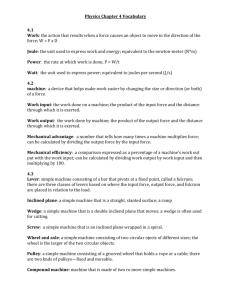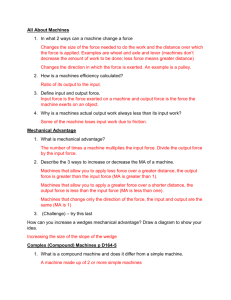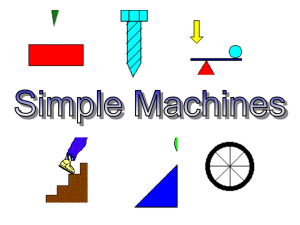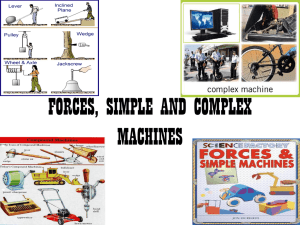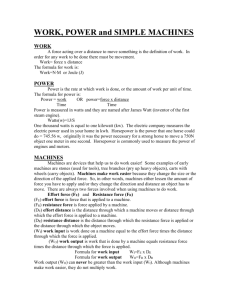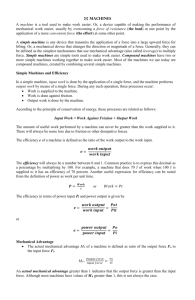Inclined Plane
advertisement
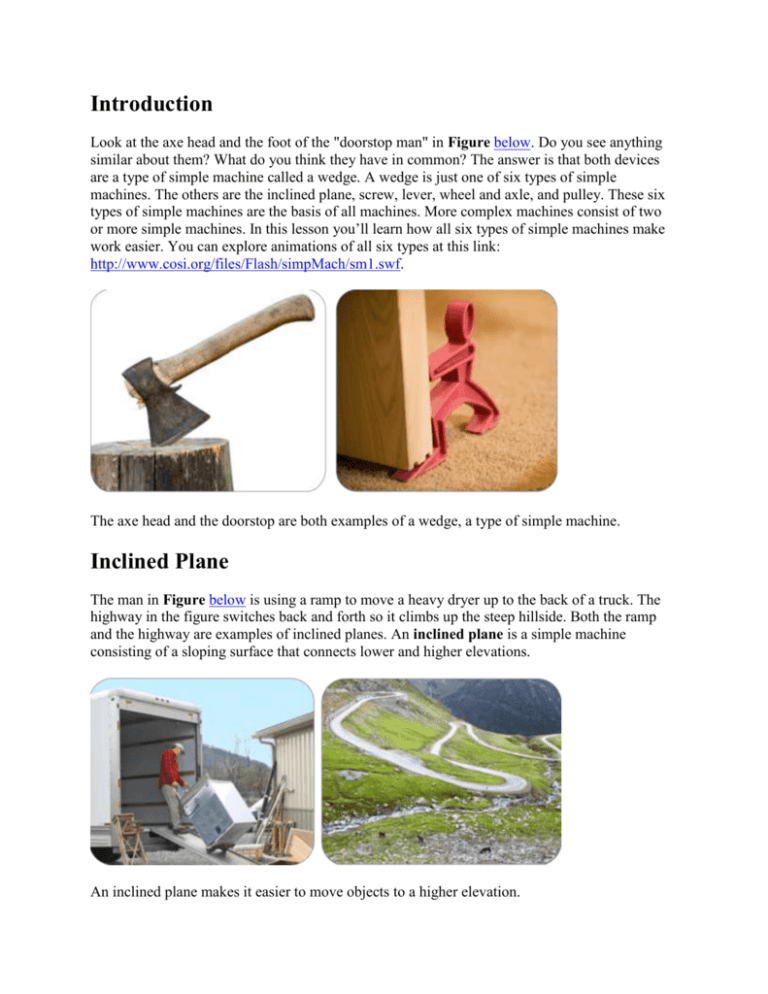
Introduction Look at the axe head and the foot of the "doorstop man" in Figure below. Do you see anything similar about them? What do you think they have in common? The answer is that both devices are a type of simple machine called a wedge. A wedge is just one of six types of simple machines. The others are the inclined plane, screw, lever, wheel and axle, and pulley. These six types of simple machines are the basis of all machines. More complex machines consist of two or more simple machines. In this lesson you’ll learn how all six types of simple machines make work easier. You can explore animations of all six types at this link: http://www.cosi.org/files/Flash/simpMach/sm1.swf. The axe head and the doorstop are both examples of a wedge, a type of simple machine. Inclined Plane The man in Figure below is using a ramp to move a heavy dryer up to the back of a truck. The highway in the figure switches back and forth so it climbs up the steep hillside. Both the ramp and the highway are examples of inclined planes. An inclined plane is a simple machine consisting of a sloping surface that connects lower and higher elevations. An inclined plane makes it easier to move objects to a higher elevation. The sloping surface of the inclined plane supports part of the weight of the object as it moves up the slope. As a result, it takes less force to move the object uphill. The trade-off is that the object must be moved over a greater distance than if it were moved straight up to the higher elevation. On the other hand, the output force is greater than the input force because it is applied over a shorter distance. Like other simple machines, the ideal mechanical advantage of an inclined plane is given by: For an inclined plane, the input distance is the length of the sloping surface, and the output distance is the maximum height of the inclined plane. This was illustrated in Figure above. Because the sloping surface is always greater than the height of the inclined plane, the ideal mechanical advantage of an inclined plane is always greater than 1. An inclined plane with a longer sloping surface relative to its height has a gentler slope. An inclined plane with a gentler slope has a greater mechanical advantage and requires less input force to move an object to a higher elevation. Wedge and Screw Two simple machines that are based on the inclined plane are the wedge and the screw. Both increase the force used to move an object because the input force is applied over a greater distance than the output force. Wedge Imagine trying to slice a tomato with a fork or spoon instead of a knife, like the one in Figure below. The knife makes the job a lot easier because of the wedge shape of the blade. A wedge is a simple machine that consists of two inclined planes. But unlike one inclined plane, a wedge works only when it moves. It has a thin end and thick end, and the thin end is forced into an object to cut or split it. The chisel in Figure below is another example of a wedge. The thin edge of a knife or chisel enters an object and forces it apart. The input force is applied to the thick end of a wedge, and it acts over the length of the wedge. The output force pushes against the object on both sides of the wedge, so the output distance is the thickness of the wedge. Therefore, the ideal mechanical advantage of a wedge can be calculated as: The length of a wedge is always greater than its maximum thickness. As a result, the ideal mechanical advantage of a wedge is always greater than 1. Screw The spiral staircase in Figure below also contains an inclined plane. Do you see it? The stairs that wrap around the inside of the walls make up the inclined plane. The spiral staircase is an example of a screw. A screw is a simple machine that consists of an inclined plane wrapped around a cylinder or cone. No doubt you are familiar with screws like the wood screw in Figure below. The screw top of the container in the figure is another example. Screws move objects to a higher elevation (or greater depth) by increasing the force applied. All of these examples are screws. Can you identify the inclined plane in each example? When you use a wood screw, you apply force to turn the inclined plane. The output force pushes the screw into the wood. It acts along the length of the cylinder around which the inclined plane is wrapped. Therefore, the ideal mechanical advantage of a screw is calculated as: The length of the inclined plane is always greater than the length of the screw. As a result, the mechanical advantage of a screw is always greater than 1. Look at the collection of screws and bolts in Figure below. In some of them, the turns (or threads) of the inclined plane are closer together. The closer together the threads are, the longer the inclined plane is relative to the length of the screw or bolt, so the greater its mechanical advantage is. Therefore, if the threads are closer together, you need to apply less force to penetrate the wood or other object. The trade-off is that more turns of the screw or bolt are needed to do the job because the distance over which the input force must be applied is greater. The threads of a screw or bolt may be closer together or farther apart. How does this affect its ideal mechanical advantage? Lever Did you ever use a hammer to pull a nail out of a board? If not, you can see how it’s done in Figure below. When you pull down on the handle of the hammer, the claw end pulls up on the nail. A hammer is an example of a lever. A lever is a simple machine consisting of a bar that rotates around a fixed point called the fulcrum. For a video introduction to levers using skateboards as examples, go to this link: http://www.youtube.com/watch?v=72ZNEactb-k (1:35). Using a hammer to remove a nail changes both the direction and strength of the applied force. Where is the fulcrum of the hammer when it is used in this way? A lever may or may not increase the force applied, and it may or may not change the direction of the force. It all depends on the location of the input and output forces relative to the fulcrum. In this regard, there are three basic types of levers, called first-class, second-class, and third-class levers. Figure below describes the three classes. Which class of lever would you use to carry a heavy load, sweep a floor, or pry open a can of paint? Comparing Classes of Levers All three classes of levers make work easier, but they do so in different ways. When the input and output forces are on opposite sides of the fulcrum, the lever changes the direction of the applied force. This occurs only with a first-class lever. When both the input and output forces are on the same side of the fulcrum, the direction of the applied force does not change. This occurs with both second- and third-class levers. When the input force is applied farther from the fulcrum, the input distance is greater than the output distance, so the ideal mechanical advantage is greater than 1. This always occurs with second-class levers and may occur with first-class levers. When the input force is applied closer to the fulcrum, the input distance is less than the output distance, so the ideal mechanical advantage is less than 1. This always occurs with third-class levers and may occur with first-class levers. When both forces are the same distance from the fulcrum, the input distance equals the output distance, so the ideal mechanical advantage equals 1. This occurs only with first class-levers. Advantage of Third-Class Levers You may be wondering why you would use a third-class lever when it doesn’t change the direction or strength of the applied force. The advantage of a third-class lever is that the output force is applied over a greater distance than the input force. This means that the output end of the lever must move faster than the input end. Why would this be useful when you are moving a hockey stick or baseball bat, both of which are third-class levers? Wheel and Axle Did you ever ride on a Ferris wheel, like the one pictured in Figure below? If you did, then you know how thrilling the ride can be. A Ferris wheel is an example of a wheel and axle. A wheel and axle is a simple machine that consists of two connected rings or cylinders, one inside the other, which both turn in the same direction around a single center point. The smaller, inner ring or cylinder is called the axle. The bigger, outer ring or cylinder is called the wheel. The car steering wheel in Figure below is another example of a wheel and axle. Both a Ferris wheel and a car steering wheel have an outer wheel and an inner axle. In a wheel and axle, force may be applied either to the wheel or to the axle. In both cases, the direction of the force does not change, but the force is either increased or applied over a greater distance. When the input force is applied to the axle, as it is with a Ferris wheel, the wheel turns with less force, so the ideal mechanical advantage is less than 1. However, the wheel turns over a greater distance, so it turns faster than the axle. The speed of the wheel is one reason that the Ferris wheel ride is so exciting. When the input force is applied to the wheel, as it is with a steering wheel, the axle turns over a shorter distance but with greater force, so the ideal mechanical advantage is greater than 1. This allows you to turn the steering wheel with relatively little effort, while the axle of the steering wheel applies enough force to turn the car. Pulley Another simple machine that uses a wheel is the pulley. A pulley is a simple machine that consists of a rope and grooved wheel. The rope fits into the groove in the wheel, and pulling on the rope turns the wheel. Figure below shows two common uses of pulleys. In both of these examples, pulling the rope turns the wheel of the pulley. Some pulleys are attached to a beam or other secure surface and remain fixed in place. They are called fixed pulleys. Other pulleys are attached to the object being moved and are moveable themselves. They are called moveable pulleys. Sometimes, fixed and moveable pulleys are used together. They make up a compound pulley. The three types of pulleys are compared in Figure below. In all three types, the ideal mechanical advantage is equal to the number of rope segments pulling up on the object. The more rope segments that are helping to do the lifting work, the less force that is needed for the job. You can experiment with an interactive animation of compound pulleys with various numbers of pulleys at this link: http://www.walterfendt.de/ph14e/pulleysystem.htm. In a single fixed pulley, only one rope segment lifts the object, so the ideal mechanical advantage is 1. This type of pulley doesn’t increase the force, but it does change the direction of the force. This allows you to use your weight to pull on one end of the rope and more easily raise the object attached to the other end. In a single moveable pulley, two rope segments lift the object, so the ideal mechanical advantage is 2. This type of pulley doesn’t change the direction of the force, but it does increase the force. In a compound pulley, two or more rope segments lift the object, so the ideal mechanical advantage is equal to or greater than 2. This type of pulley may or may not change the direction of the force, depending on the number and arrangement of pulleys. When several pulleys are combined, the increase in force may be very great. To learn more about the mechanical advantage of different types of pulleys, watch the video at this link: http://video.google.com/videoplay?docid=8517358537561483069#. Single pulleys may be fixed or moveable. Compound pulleys consist of two or more pulleys. Lesson Summary An inclined plane is a simple machine consisting of a sloping surface that connects lower and higher elevations. The ideal mechanical advantage of an inclined plane is always greater than 1. A wedge is a simple machine that consists of two inclined planes. A screw is a simple machine that consists of an inclined plane wrapped around a cylinder or cone. The ideal mechanical advantage of wedges and screws is always greater than 1. A lever is a simple machine that consists of a bar that rotates around a fixed point called the fulcrum. There are three classes of levers. Depending on its class, a lever may have an ideal mechanical advantage that is less than, equal to, or greater than 1. First-class levers also change the direction of the input force. A wheel and axle is a simple machine that consists of two connected rings or cylinders, one inside the other, which both turn in the same direction around a single center point. When force is applied to the inner axle, the ideal mechanical advantage is less than 1. When force is applied to the outer wheel, the ideal mechanical advantage is greater than 1. A pulley is a simple machine that consists of a rope and grooved wheel. Single pulleys may be fixed or moveable. Single and moveable pulleys may be combined in a compound pulley. The ideal mechanical advantage of a pulley or compound pulley is always equal to or greater than 1. Fixed pulleys and some compound pulleys also change the direction of the input force.


